Inspection Interval Optimization for Aircraft Composite Tail Wing Structure Using Numerical-Analysis-Based Approach
Abstract
1. Introduction
2. Proposed Finite-Element-Analysis-Based Inspection Interval Optimization Approach
- Phase 1.
- The geometry, fatigue-loading spectrum data, and skin-debonding damage case scenario of the KT-100 aircraft tail wing structure were obtained from KAI.
- Phase 2.
- A fatigue delamination damage model was developed for a simple composite specimen and extended to the full-scale aircraft tail wing geometry.
- Phase 3.
- The uncertainty of mechanical parameters was included, and the design of experiments was created based on Latin hypercube sampling (LHS) scenarios.
- Phase 4.
- A Monte Carlo simulation was performed by building a response surface model.
- Phase 5.
- Risk assessment and inspection interval optimization of the tail wing structure were undertaken.
2.1. Development of the Finite Element Model
2.2. Sensitivity Analysis and Design of Experiments (DOE)
3. Risk Assessment and Inspection Interval Optimization
- Step #1. Determination of the severity category
- Step #2. Calculation of the probability of failure (probability level)
- Step #3. Risk assessment code
4. Conclusions
- The FEA model based on VCCT and Paris’ law was implemented and compared with a real experimental curve. The fatigue damage model was extended to a full aircraft tail wing geometry and the fatigue delamination growth curve was computed.
- A sensitivity analysis was undertaken to check the effect of mechanical parameters on the fatigue delamination growth curve; E1 and G23 were found to be the most sensitive parameters. The Latin hypercube sampling technique was used for the DOE data generation scenarios, where 30 scenarios were generated. Based on LHS, an efficient response surface was generated. A damage growth simulation was performed using an MCS.
- In the end, a probabilistic risk analysis method was proposed based on the risk matrix of the US military specification, and the risk was analyzed based on the severity and frequency of structural failure. In future research, based on the process of determining the optimal inspection cycle, we will consider both the risk and the cost associated with the inspection.
Author Contributions
Funding
Conflicts of Interest
Appendix A
| Scenario Number (#) | E1 (MPa) | G23 (MPa) | Scenario # | E1 (MPa) | G23 (MPa) |
|---|---|---|---|---|---|
| 1 | 139.7615909 | 3.438312739 | 16 | 138.6539501 | 3.506192126 |
| 2 | 141.3938702 | 3.56605425 | 17 | 138.7957379 | 3.587573885 |
| 3 | 138.0581118 | 3.678908272 | 18 | 139.5075777 | 3.609318242 |
| 4 | 139.1752097 | 3.532368614 | 19 | 137.7304732 | 3.486625586 |
| 5 | 138.4700897 | 3.575752631 | 20 | 139.9177379 | 3.581053108 |
| 6 | 135.5688385 | 3.501017317 | 21 | 137.4000267 | 3.51591805 |
| 7 | 140.1825004 | 3.523911518 | 22 | 138.4367088 | 3.542198006 |
| 8 | 139.3109788 | 3.600841752 | 23 | 139.6792856 | 3.406417978 |
| 9 | 137.4727095 | 3.482559356 | 24 | 138.2926045 | 3.385928254 |
| 10 | 138.9296798 | 3.628621725 | 25 | 137.8217986 | 3.558572124 |
| 11 | 138.1894966 | 3.551958713 | 26 | 139.2390456 | 3.520360535 |
| 12 | 140.9149363 | 3.445628384 | 27 | 137.1665889 | 3.57807592 |
| 13 | 136.9461698 | 3.465241411 | 28 | 138.2448875 | 3.616984057 |
| 14 | 140.4141209 | 3.550065463 | 29 | 139.615228 | 3.423103266 |
| 15 | 140.7574458 | 3.638565444 | 30 | 141.2357918 | 3.711960967 |
References
- Manco, P.; Caterino, M.; Macchiaroli, R.; Rinaldi, M.; Fera, M. Aircraft Maintenance: Structural Health Monitoring Influence on Costs and Practices; Wiley: Hoboken, NJ, USA, 2021; Volume 396, p. 2000302. [Google Scholar]
- Wild, G.; Pollock, L.; Abdelwahab, A.K.; Murray, J. The Need for Aerospace Structural Health Monitoring: A Review of Aircraft Fatigue Accidents. Int. J. Progn. Health Manag. 2021, 12. [Google Scholar] [CrossRef]
- Temucin, T.; Tuzkaya, G.; Vayvay, O. Aircraft Maintenance Routing Problem–A Literature Survey. Promet-Traffic Transp. 2021, 33, 491–503. [Google Scholar] [CrossRef]
- Healey, R.; Wang, J.; Chiu, W.K.; Chowdhury, N.M.; Baker, A.; Wallbrink, C. A Review on Aircraft Spectra Simplification Techniques for Composite Structures. Compos. Part C Open Access 2021, 5, 100131. [Google Scholar] [CrossRef]
- Das, M.; Sahu, S.; Parhi, D. Composite Materials and Their Damage Detection Using AI Techniques for Aerospace Application: A Brief Review. Mater. Today Proc. 2021, 44, 955–960. [Google Scholar] [CrossRef]
- Khalid, S.; Lee, J.; Kim, H.S. Series Solution-Based Approach for the Interlaminar Stress Analysis of Smart Composites under Thermo-Electro-Mechanical Loading. Mathematics 2022, 10, 268. [Google Scholar] [CrossRef]
- Khalid, S.; Kim, H.S. Recent Studies on Stress Function-Based Approaches for the Free Edge Stress Analysis of Smart Composite Laminates: A Brief Review. Multiscale Sci. Eng. 2022, 4, 73–78. [Google Scholar] [CrossRef]
- Khalid, S.; Kim, H.S. Progressive Damage Modeling of Inter and Intra Laminar Damages in Open Hole Tensile Composite Laminates. JCOSEIK 2019, 32, 233–240. [Google Scholar] [CrossRef]
- Teimouri, F.; Heidari-Rarani, M.; Aboutalebi, F.H. An XFEM-VCCT Coupled Approach for Modeling Mode I Fatigue Delamination in Composite Laminates under High Cycle Loading. Eng. Fract. Mech. 2021, 249, 107760. [Google Scholar] [CrossRef]
- Ahmadi, A.; Söderholm, P.; Kumar, U. On Aircraft Scheduled Maintenance Program Development. J. Qual. Maint. Eng. 2010, 3, 229–255. [Google Scholar] [CrossRef]
- Jing, C.; Dingqiang, D. Inspection Interval Optimization for Aircraft Composite Structures with Dent and Delamination Damage. J. Syst. Eng. Electron. 2021, 32, 252–260. [Google Scholar] [CrossRef]
- Ushakov, A.; Stewart, A.; Mishulin, I.; Pankov, A. Probabilistic Design of Damage Tolerant Composite Aircraft Structures; Federal Aviation Administration, Office of Aviation Research: Washington, DC, USA, 2002. [Google Scholar]
- Kan, H.-P.; Kane, D. Probabilistic Certification of Integrally Bonded Composite Structures—An Assessment; American Institute of Aeronautics and Astronautics: Denver, CO, USA, 2002; p. 1388. [Google Scholar]
- Lin, K.Y.; Styuart, A.V. Probabilistic Approach to Damage Tolerance Design of Aircraft Composite Structures. J. Aircr. 2007, 44, 1309–1317. [Google Scholar] [CrossRef]
- Dinis, D.; Barbosa-Póvoa, A.; Teixeira, Â.P. Valuing Data in Aircraft Maintenance through Big Data Analytics: A Probabilistic Approach for Capacity Planning Using Bayesian Networks. Comput. Ind. Eng. 2019, 128, 920–936. [Google Scholar] [CrossRef]
- Giannella, V. Uncertainty Quantification in Fatigue Crack-Growth Predictions. Int. J. Fract. 2022, 235, 179–195. [Google Scholar] [CrossRef]
- Zhu, M.; Gorbatikh, L.; Lomov, S.V. An Incremental-Onset Model for Fatigue Delamination Propagation in Composite Laminates. Compos. Sci. Technol. 2020, 200, 108394. [Google Scholar] [CrossRef]
- Zhou, S.; Li, Y.; Fu, K.; Wu, X. Progressive Fatigue Damage Modelling of Fibre-Reinforced Composite Based on Fatigue Master Curves. Thin-Walled Struct. 2021, 158, 107173. [Google Scholar] [CrossRef]
- Dávila, C. From SN to the Paris Law with a New Mixed-Mode Cohesive Fatigue Model for Delamination in Composites. Theor. Appl. Fract. Mech. 2020, 106, 102499. [Google Scholar] [CrossRef]
- Raimondo, A.; Doesburg, S.; Bisagni, C. Numerical Study of Quasi-Static and Fatigue Delamination Growth in a Post-Buckled Composite Stiffened Panel. Compos. Part B Eng. 2020, 182, 107589. [Google Scholar] [CrossRef]
- Abaqus Analysis User’s Manual-Abaqus Version 6.14; Simulia: Johnston, RI, USA.
- Rozylo, P. Experimental-Numerical Study into the Stability and Failure of Compressed Thin-Walled Composite Profiles Using Progressive Failure Analysis and Cohesive Zone Model. Compos. Struct. 2021, 257, 113303. [Google Scholar] [CrossRef]
- Chen, S.; Mitsume, N.; Bui, T.Q.; Gao, W.; Yamada, T.; Zang, M.; Yoshimura, S. Development of Two Intrinsic Cohesive Zone Models for Progressive Interfacial Cracking of Laminated Composites with Matching and Non-Matching Cohesive Elements. Compos. Struct. 2019, 229, 111406. [Google Scholar] [CrossRef]
- Liang, Y.-J.; Dávila, C.G.; Iarve, E.V. A Reduced-Input Cohesive Zone Model with Regularized Extended Finite Element Method for Fatigue Analysis of Laminated Composites in Abaqus. Compos. Struct. 2021, 275, 114494. [Google Scholar] [CrossRef]
- Heidari-Rarani, M.; Sayedain, M. Finite Element Modeling Strategies for 2D and 3D Delamination Propagation in Composite DCB Specimens Using VCCT, CZM and XFEM Approaches. Theor. Appl. Fract. Mech. 2019, 103, 102246. [Google Scholar] [CrossRef]
- NASA/TM-2008-215123; An Approach to Assess Delamination Propagation Simulation Capabilities in Commercial Finite Element Codes. National Aeronautics and Space Administration: Hampton, VA, USA, 2008.
- Munagala, P. Fatigue Life Prediction of GFRP Composite Material at Coupon and Component Level. Master’s Thesis, West Virginia University Libraries, Morgantown, WV, USA, 2005. [Google Scholar]
- Chamis, C.C. Probabilistic Simulation of Multi-Scale Composite Behavior. Theor. Appl. Fract. Mech. 2004, 41, 51–61. [Google Scholar] [CrossRef]
- Matala, A. Sample Size Requirement for Monte Carlo Simulations Using Latin Hypercube Sampling; Helsinki University of Technology: Espoo, Finland, 2008; Volume 25. [Google Scholar]
- Domyancic, L.; McFarland, J.M.; Cardinal, J.W. Review of Methods for Calculating Single Flight Probability of Failure. In Proceedings of the AIAA Scitech 2021 Forum, Virtual Event, 11–15 & 19–21 January 2021; p. 1490. [Google Scholar]
- Altowairqi, M.M. Evaluation of RSAF Airworthiness and Applicability; Air Force Institute of Technology Wright-Patterson: Wright-Patterson AFB, OH, USA, 2018. [Google Scholar]


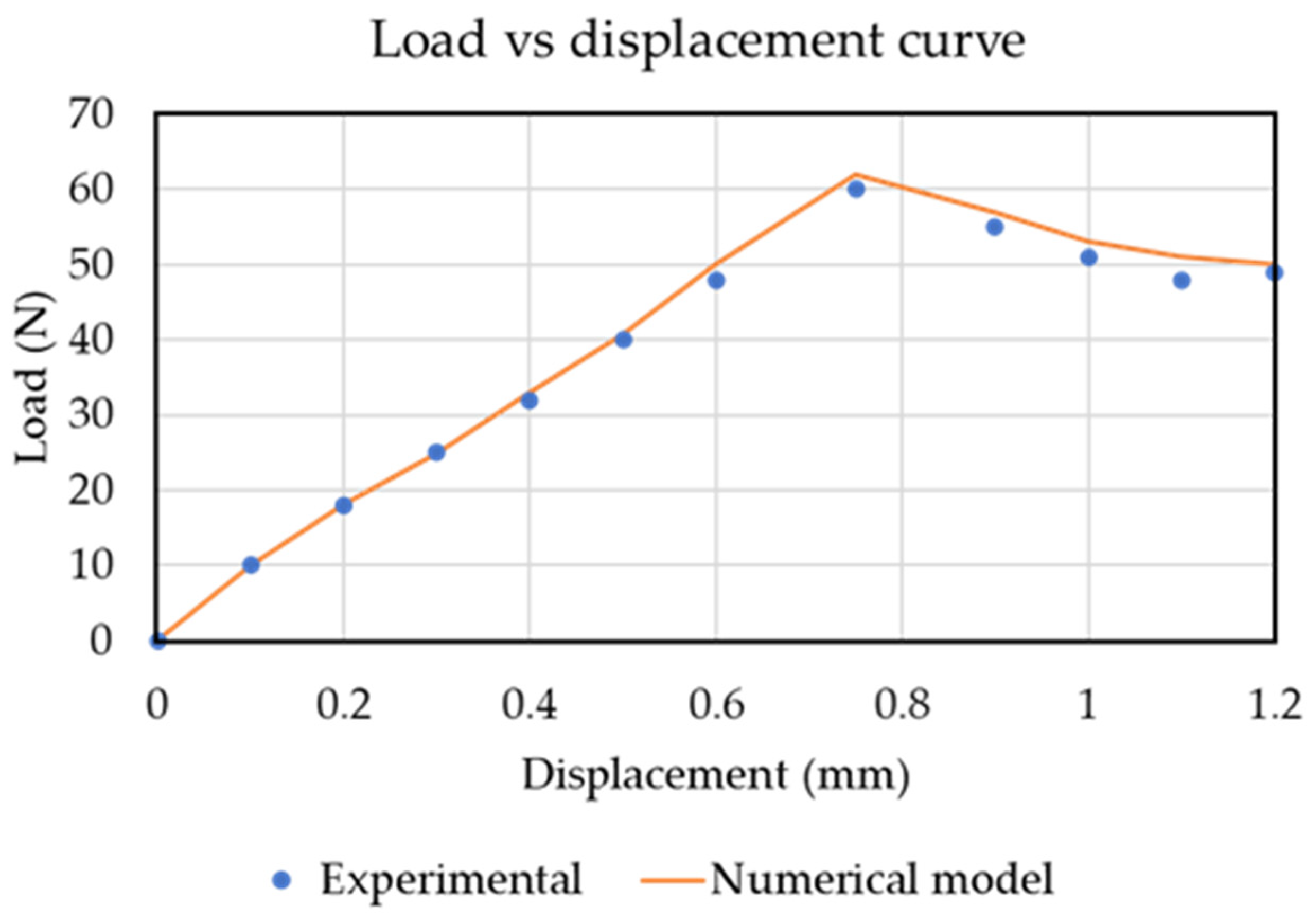
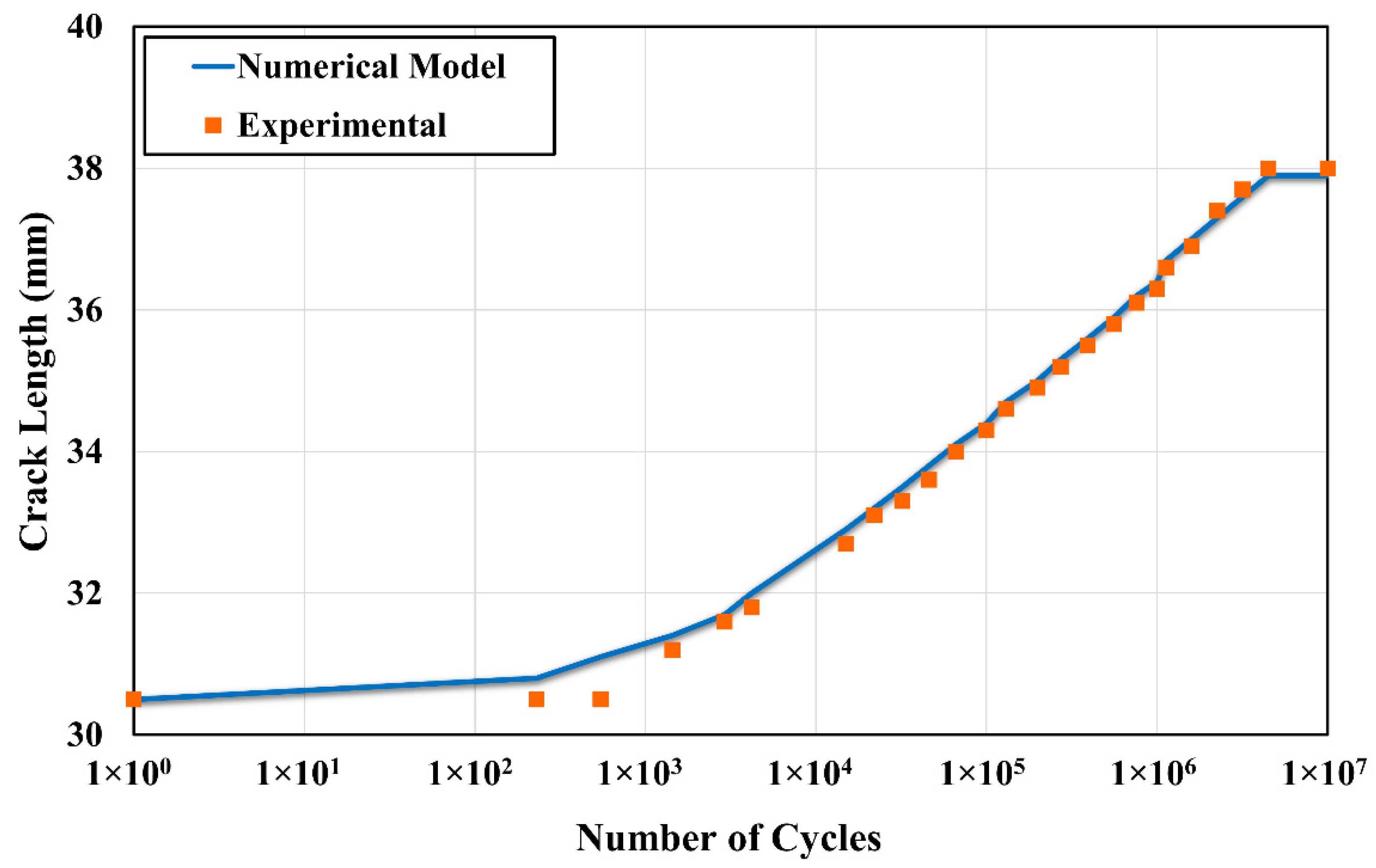


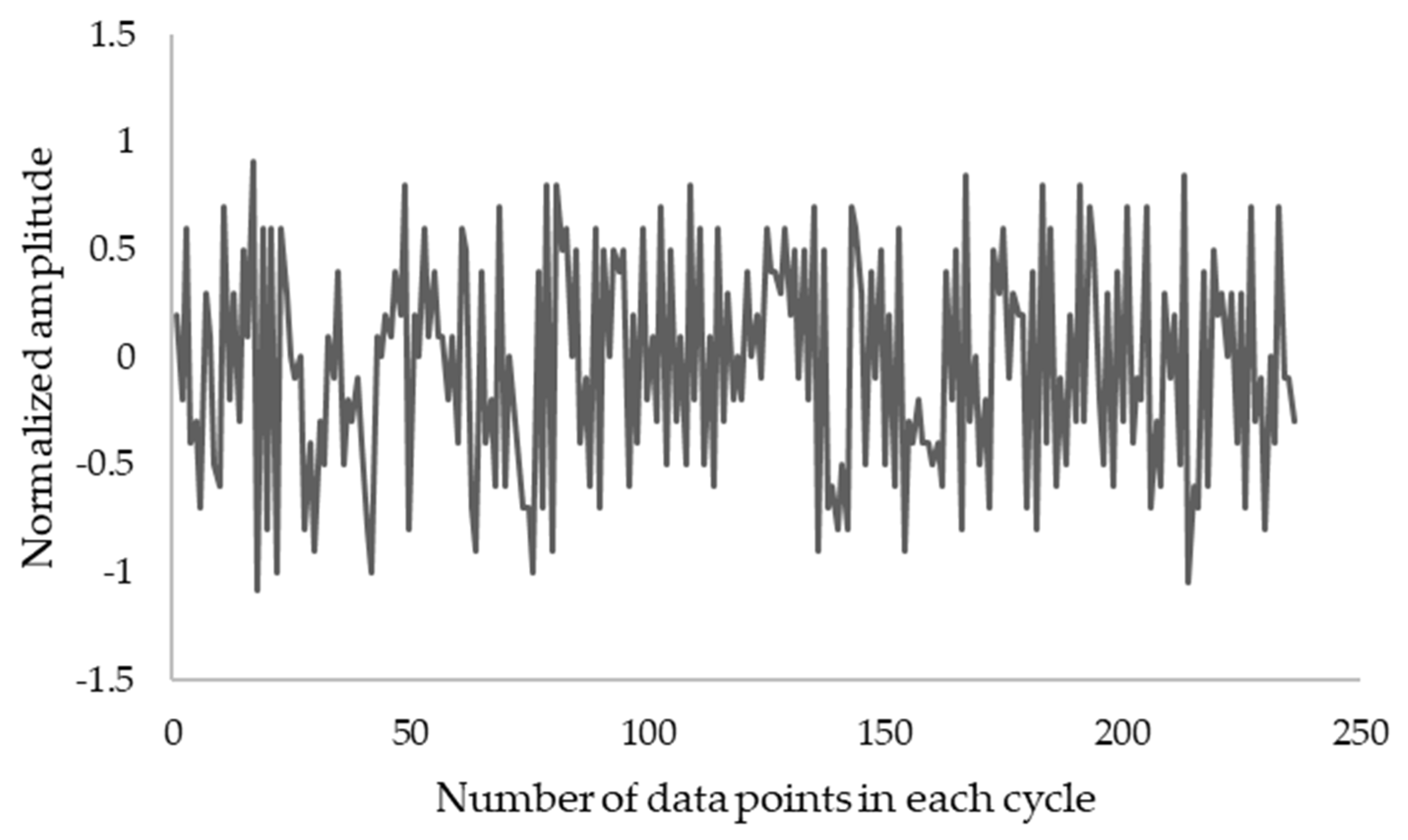
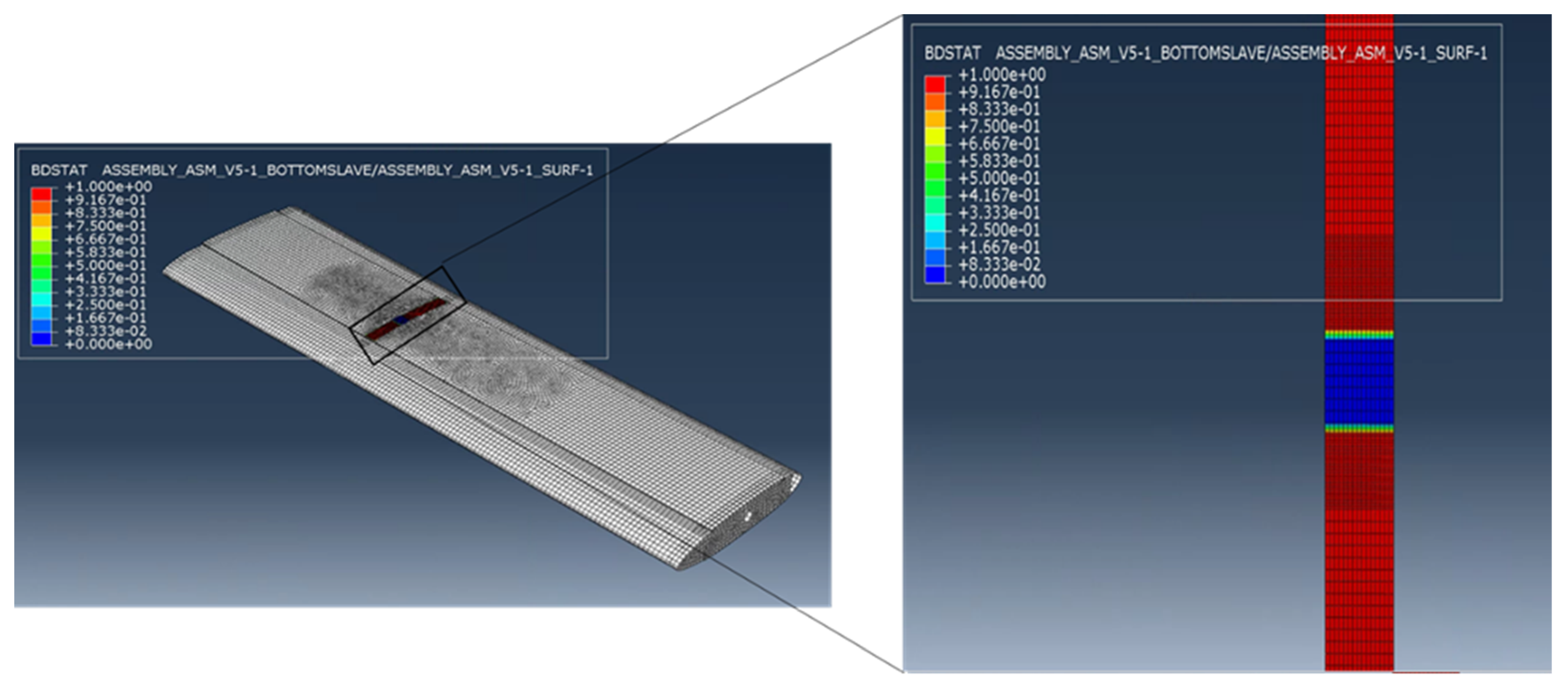
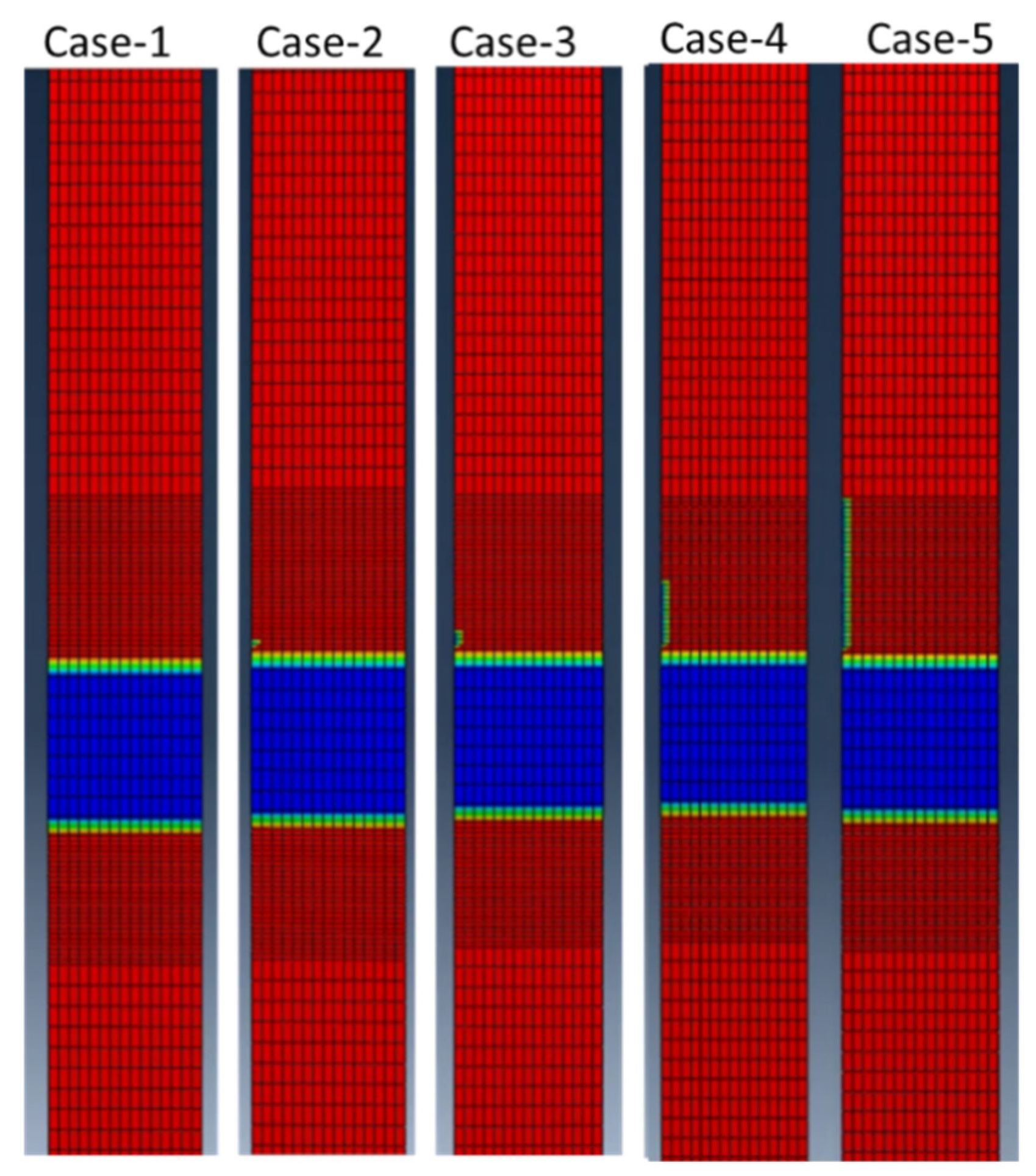
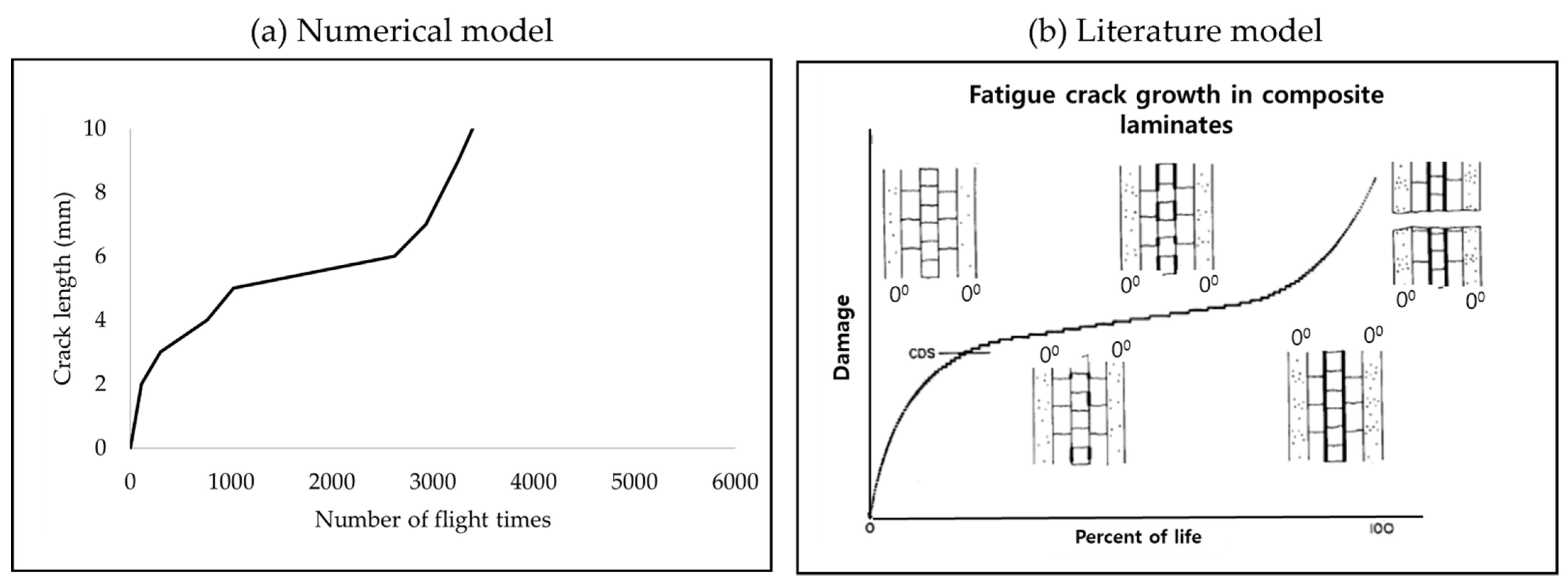
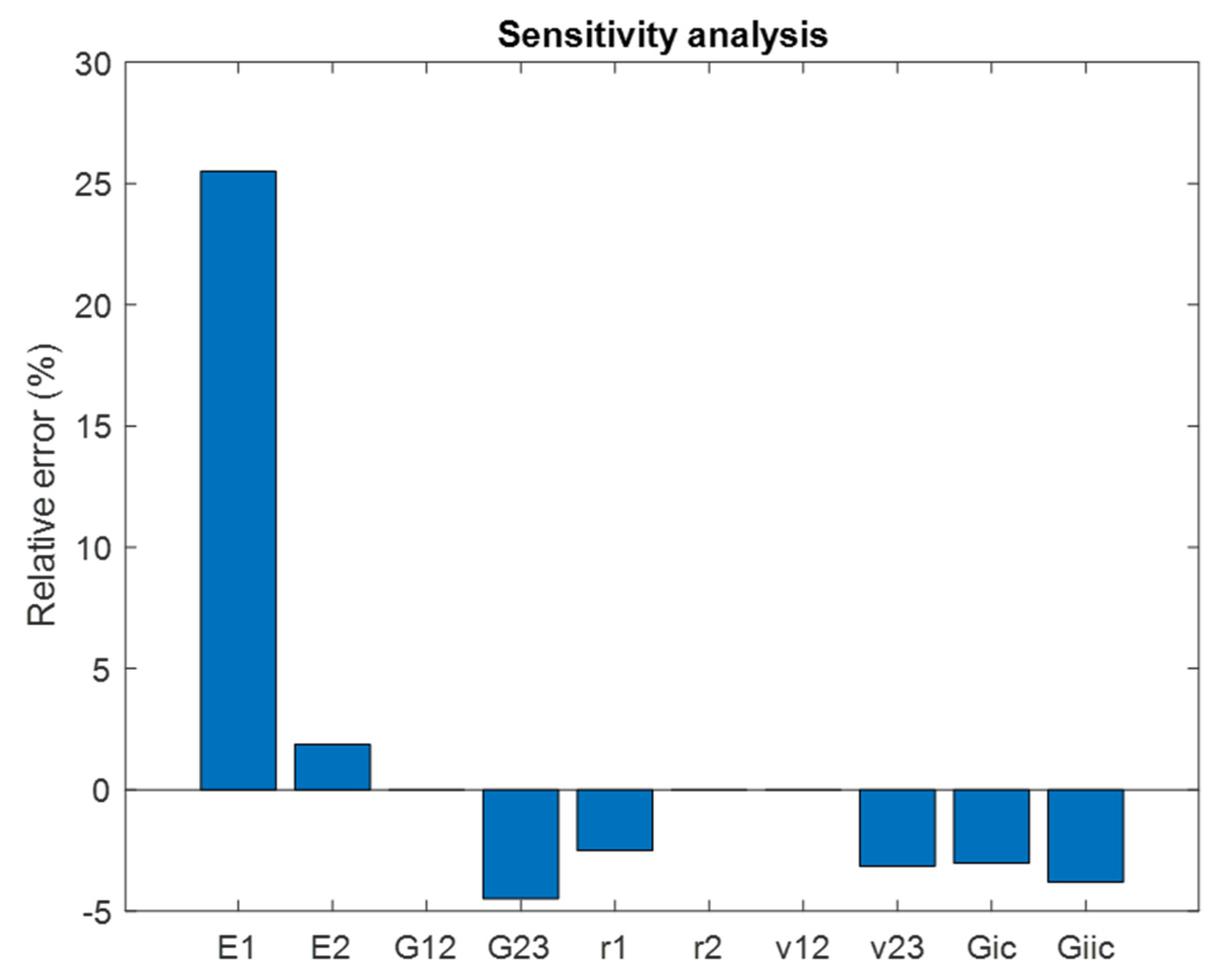
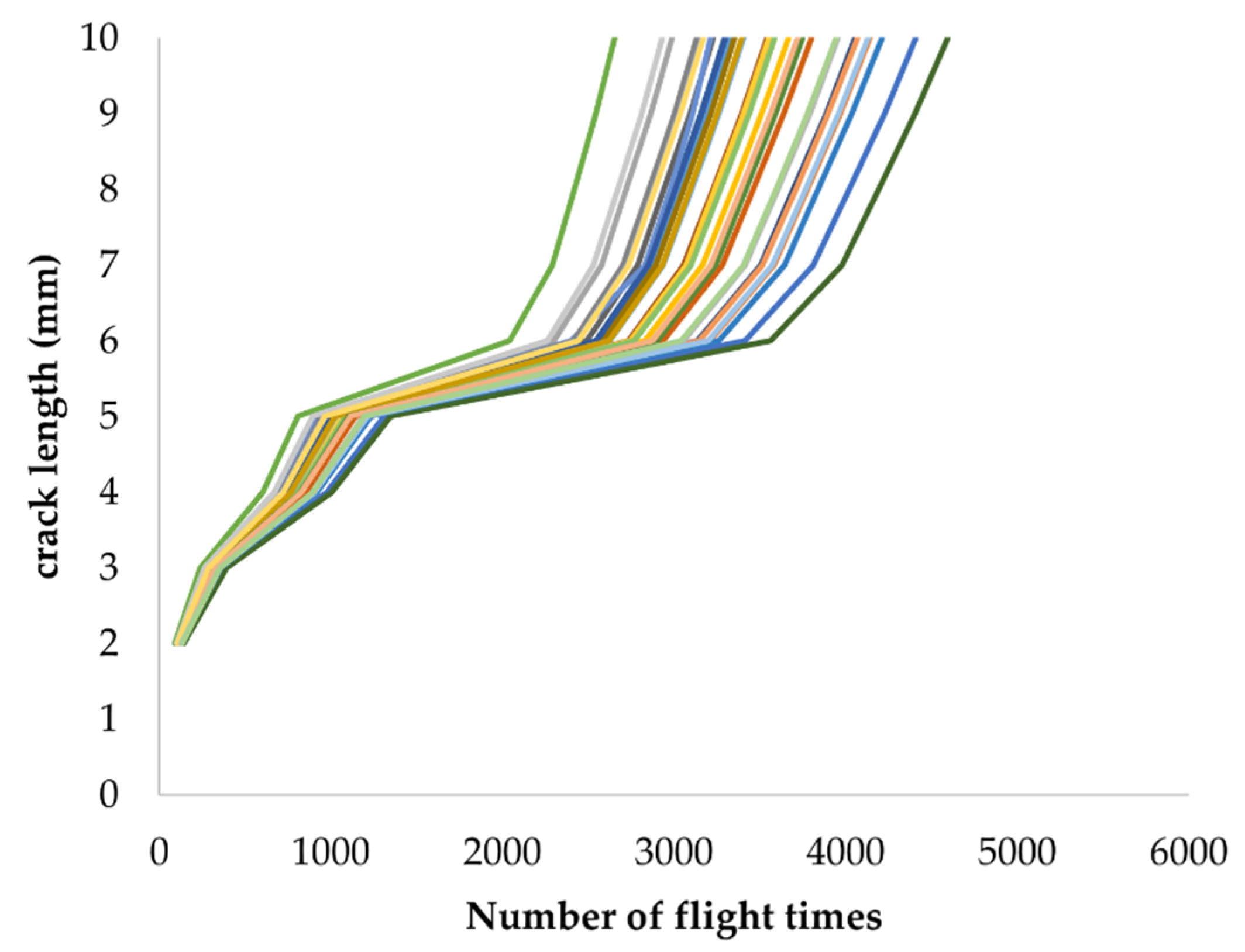
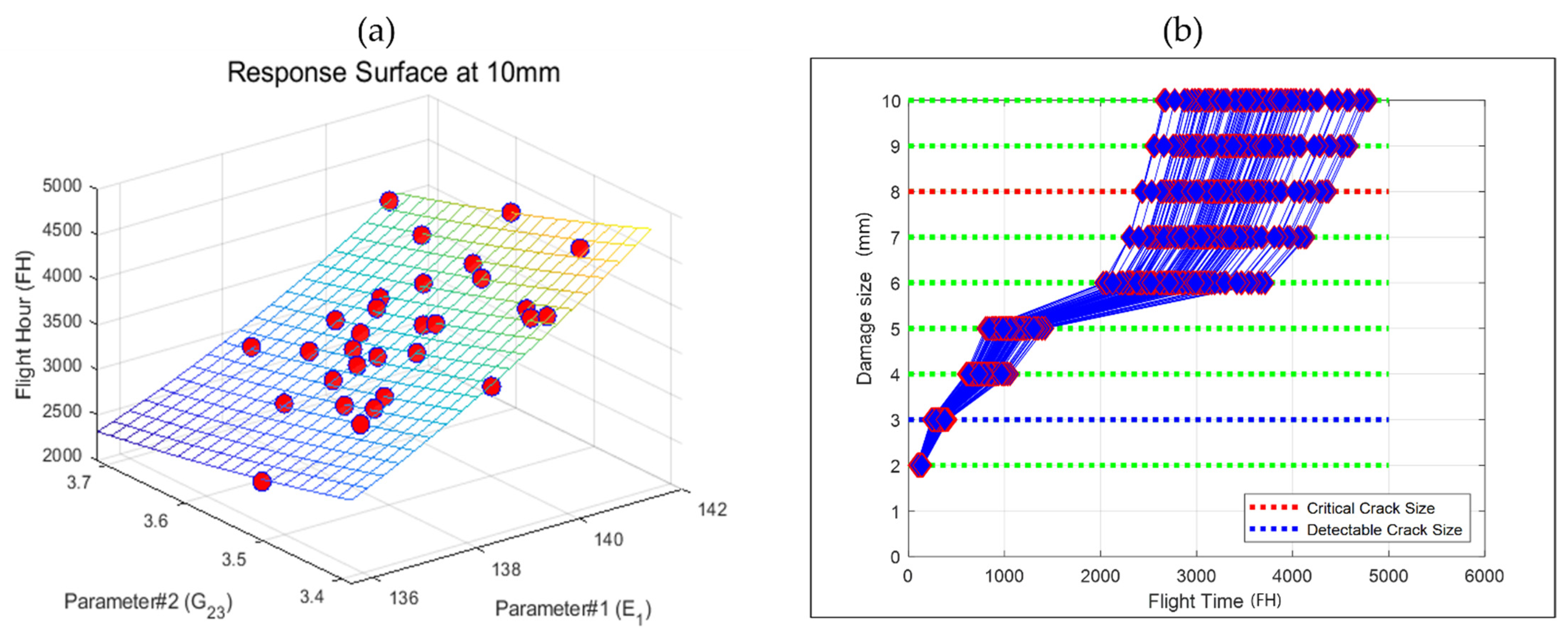
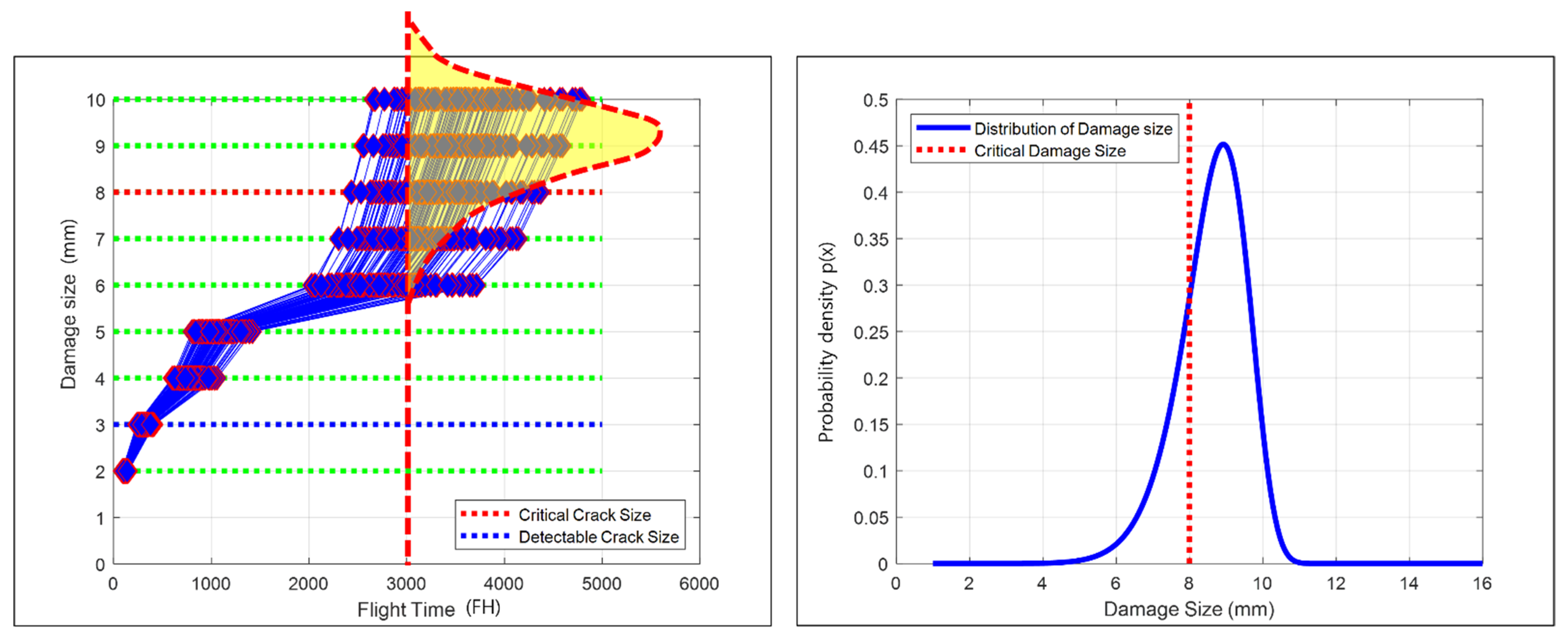

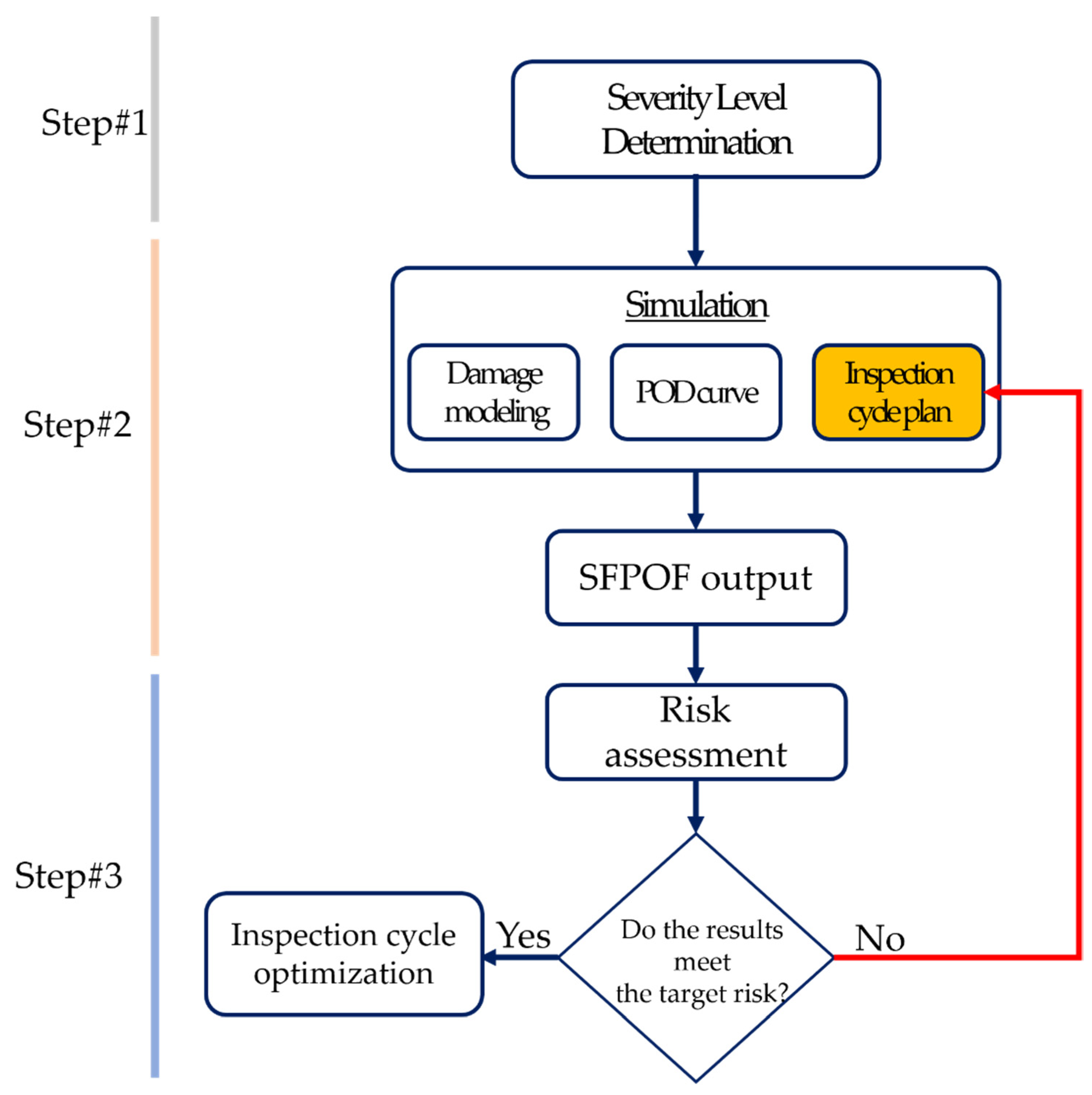
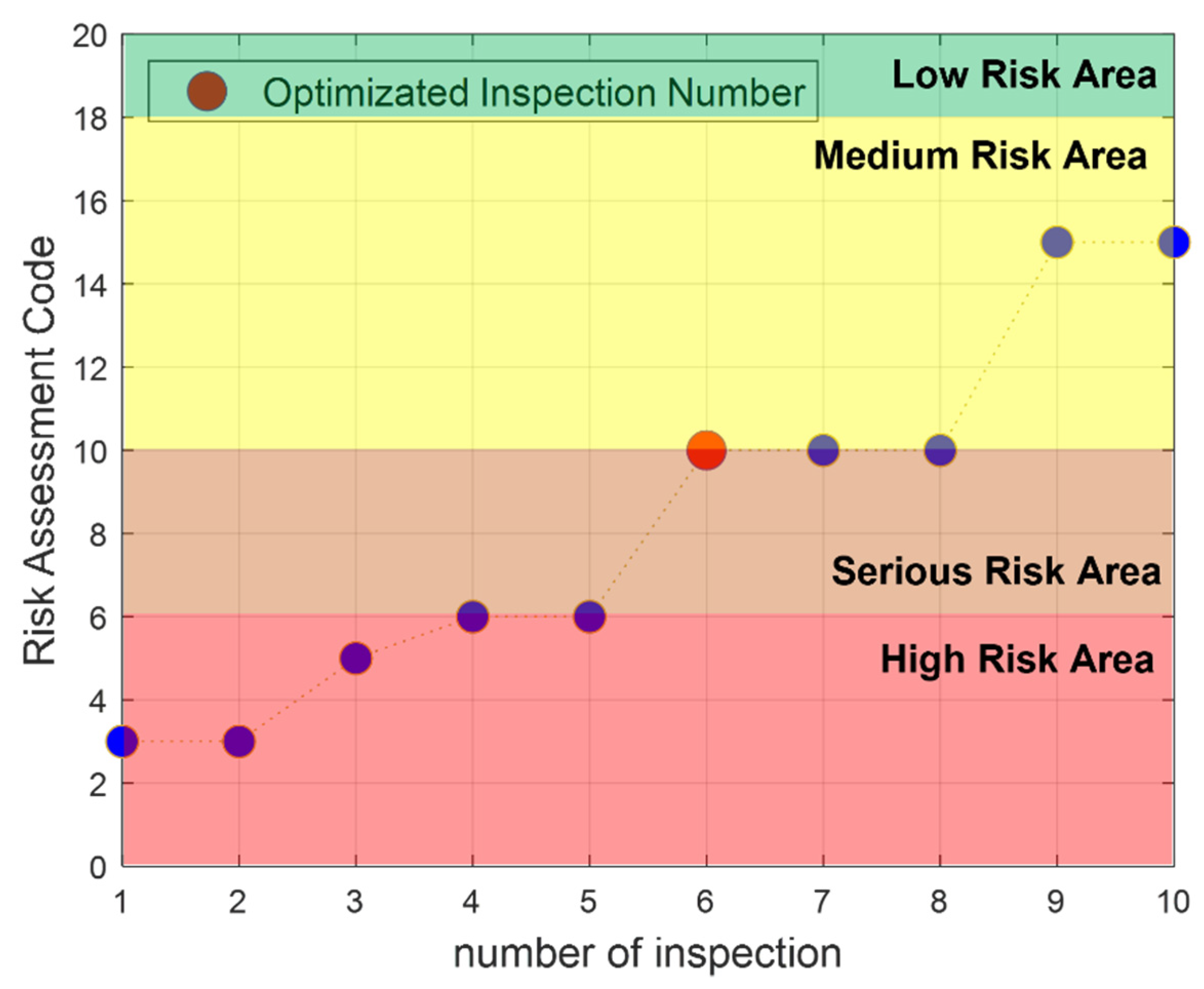
| Parameters | Notations | Value |
|---|---|---|
| Elastic modulus in direction 1 | E1 | 139,400 MPa |
| Elastic modulus in directions 2 and 3 | E2 = E3 | 10,160 MPa |
| Shear modulus in directions 12 and 13 | G12 = G13 | 4600 MPa |
| Shear modulus in direction 23 | G23 | 3540 MPa |
| Poisson’s ratio in direction 12 and 13 | ν12 | 0.3 |
| Poisson’s ratio in direction 23 | ν23 | 0.436 |
| Fracture toughness in direction 1 | GIC | 0.17 kJ/m2 |
| Fracture toughness in direction 2 | GiiC | 0.49 kJ/m2 |
| Lower fatigue crack growth threshold | r1 | 0.67 |
| Upper fatigue crack growth threshold | r2 | 0.067 |
| Case Simulation | Applied Shear Force Magnitude | Load Increase (%) |
|---|---|---|
| Case 1 | 1.849 KN | - |
| Case 2 | 2.2 KN | 18.9% |
| Case 3 | 2.6 KN | 40.6% |
| Case 4 | 3.0 KN | 62.2% |
| Case 5 | 3.7 KN | 100% |
| USAF Airworthiness Risk Assessment Matrix | Severity Category | |||||
|---|---|---|---|---|---|---|
| Probability Level | Probability per FH or Sortie | Freq per 100 K FH or 100 K Sorties | Catastrophic (1) | Critical (2) | Marginal (3) | Negligible (4) |
| Frequent (A) | Prob | 1 | 3 | 7 | 13 | |
| Probable (B) | 2 | 5 | 9 | 16 | ||
| Occasional (C) | 4 | 6 | 11 | 18 | ||
| Remote (D) | 8 | 10 | 14 | 19 | ||
| Improbable (E) | 12 | 15 | 17 | 20 | ||
| Eliminated (F) | Prob = 0 | Freq = 0 | Eliminated | |||
Publisher’s Note: MDPI stays neutral with regard to jurisdictional claims in published maps and institutional affiliations. |
© 2022 by the authors. Licensee MDPI, Basel, Switzerland. This article is an open access article distributed under the terms and conditions of the Creative Commons Attribution (CC BY) license (https://creativecommons.org/licenses/by/4.0/).
Share and Cite
Khalid, S.; Kim, H.-S.; Kim, H.S.; Choi, J.-H. Inspection Interval Optimization for Aircraft Composite Tail Wing Structure Using Numerical-Analysis-Based Approach. Mathematics 2022, 10, 3836. https://doi.org/10.3390/math10203836
Khalid S, Kim H-S, Kim HS, Choi J-H. Inspection Interval Optimization for Aircraft Composite Tail Wing Structure Using Numerical-Analysis-Based Approach. Mathematics. 2022; 10(20):3836. https://doi.org/10.3390/math10203836
Chicago/Turabian StyleKhalid, Salman, Hee-Seong Kim, Heung Soo Kim, and Joo-Ho Choi. 2022. "Inspection Interval Optimization for Aircraft Composite Tail Wing Structure Using Numerical-Analysis-Based Approach" Mathematics 10, no. 20: 3836. https://doi.org/10.3390/math10203836
APA StyleKhalid, S., Kim, H.-S., Kim, H. S., & Choi, J.-H. (2022). Inspection Interval Optimization for Aircraft Composite Tail Wing Structure Using Numerical-Analysis-Based Approach. Mathematics, 10(20), 3836. https://doi.org/10.3390/math10203836







